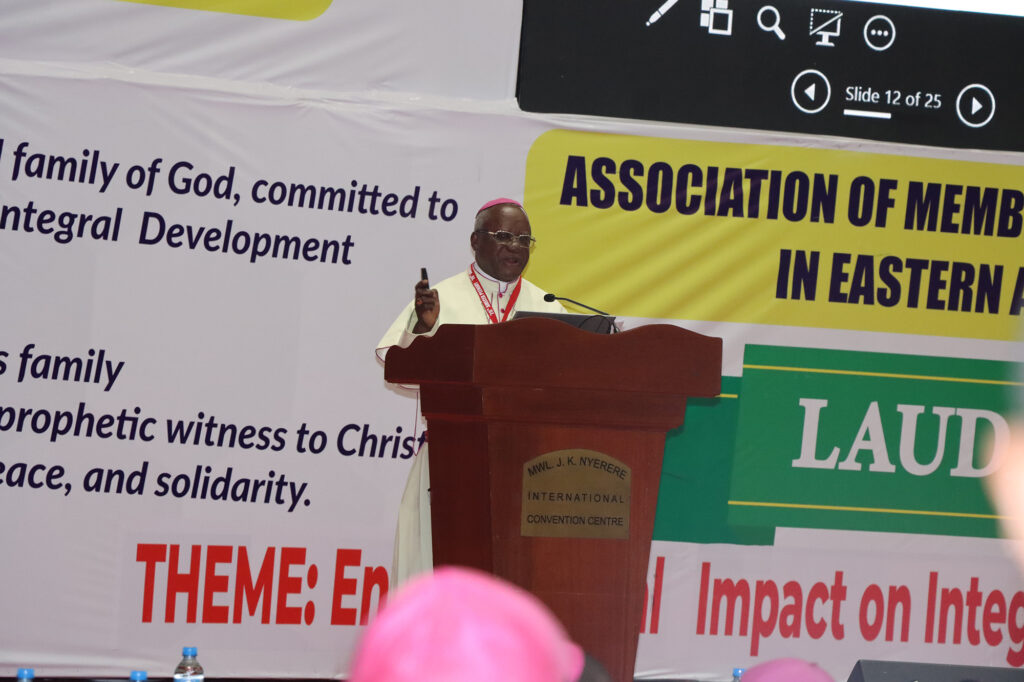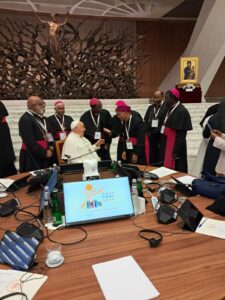AMECEA PLENARY: Unity and Pastoral solidarity are key to common evangelization, AMECEA Looks at its Historical Roots

By Luke Bisani
Bearing in mind a saying that goes “People without the knowledge of their past history, origin and culture is like they are like trees without roots”, the Bishops present at the AMECEA 20th Plenary Assembly in Dar es Salaam-Tanzania, looked back at the driving forces that brought bishops together in Tanganyika in 1960 and witnessed the birth of the striving Association of Bishop’s conferences in eastern Africa.
Now with 61 years from the time the first plenary was held in 1961 in Tanzania, AMECEA bishops reflected at the path taken to appreciate the existence of the assembly with the first theme being on the “The Future of the Church in Africa”.
The Vatican II Council at St. Anselmo College in November 1964 provided yet another opportunity to the bishops to discuss for the 2nd Plenary Assembly on matters concerning the region away from the AMECEA soil.
The 2nd Plenary in Rome-Italy provided a platform to discuss the First Constitution of the Regional association (that was approved), the change of name from ITEBEA (Inter-Regional Episcopal Board in Eastern Africa) to AMECEA, ushering of Bishop Vincent McCauley as the First Chairman of the AMECEA to single-out some on that list.
Three years later, the bishops convened in Nairobi-Kenya where pastoral matters were at the centre of the meeting. The Nairobi Plenary Assembly laid a foundation for the establishment of AMECEA Research Department, Religious Education Department and AMECEA Social Communications Department.
With the growth in the Population in the Africa and the AMECEA region in particular, the bishops from the AMECEA region sort another audience that was held in Zambia for the 4th Plenary Assembly in 1970.
While in Zambia, the Bishops shared more on the growing number of Catholic faithful and the need for Priests, they also looked at the need for proper formation in line with African context and appreciated the role of the Seminaries in as far as solving their puzzle on the growing numbers of Christians and need of priests in Africa.
The Conference of Catholic Bishops in Kenya got that excitement of hosting the AMECEA as they warmly welcomed delegates of the 5th Plenary Assembly in Nairobi for the second time in 1973 before other conference had dared to host such a high-profile meeting in their countries.
The 5th plenary Assembly brought on the table a food of thought on how the bishops were to plan for the Church in Eastern Africa in the 1980s.
“We are convinced that in these countries of Eastern Africa, it is time for the Church to become really ‘local’. We believe that in order to achieve this we have to insist on building Church life and work on the Small Communities,” echoed the bishops then.
In 1976, Kenya for the third time hosted the AMECEA’s 6th Plenary Assembly that focused on the Building Small Christian Communities in Eastern Africa. Three years down the line, Malawi took the challenge of hosting the AMECEA delegates in Zomba with focus on evaluating the resolutions made at the 6th Plenary.
The 8th Plenary Assembly focused on the “Common Concerns of the Church in Eastern Africa” and delegates at the meeting in Kenya for the fourth time witnessed the Catholic Bishops establishing the Catholic Higher Institute of Eastern Africa (CHIEA) now CUEA.
In 1986, the mantle of organising the 9th plenary Assembly for the Catholic Bishops was left in the hands of Tanzania in Moshi where delegates were more interested to look at “Families: Truly Christian and Truly African”. As the world was moving towards the 21st Century, the Catholic Bishops met in Kampala-Uganda where the focused their deliberation on the Youths.
After the 1989 plenary in Uganda, the bishops met in Lusaka-Zambia for the 11th Plenary Assembly in 1992 where issues centred on Evangelization were primed during the meeting. Inculturation, Small Christian Communities and Priestly, Religious and Christian Formation were discussed before having resolutions on them.
Three years after the Malawi Bishop’s had written their controversial pastoral letter, Living Our Faith, the conference was brave enough to prepare for the 12th Plenary in Mangochi where the energy was put on looking at the role of the Church in Development in the Light of the African Synod.

After a break, the AMECEA delegates were invited to visit Nairobi in Kenya for the 13th Plenary Assembly where they discussed on Formation of Agents of Evangelization for the Church as Family of God.
Two years after the world had celebrated the second millennium, the Catholic Bishops were yet again in Dar es Salaam-Tanzania where issues of Evangelizations in the third millennium where tabled for the delegates.
As African countries were hit with the HIV/AIDS pandemic, the bishops brought to their attention the issue to be discussed for the 15th Plenary Assembly in 2005 that was held in Kampala- Uganda. The meeting that followed later in 2008 in Lusaka-Zambia focused on the need to have “Reconciliation through Justice and Peace.
As the Assembly was celebrating the 50 years of existence in Kenya, the delegates throne their celebration on Evangelization in Solidarity as the theme of the 17th plenary. With over 50 years of the existence, the bishops met in Lilongwe in Malawi were New Evangelization through True Conversion and Witnessing to Christian Faith was theme for the 18th plenary.
The 19th plenary Assembly in Addis Ababa-Ethiopia, put on the table of the delegates matters on Vibrant Diversity, Equal Dignity, Peaceful Unity in God in the AMECEA Region.
As Bishop Method Kilaini from Tanzania was leaving the podium, after taking the delegates through the roots of AMECEA at the 20th plenary Assembly in Dar es Salaam his face wore smiles knowing that indeed AMECEA was born out of a desire for having a common pastoral approach to issues of common interest in the region. The clapping of hands from the delegates after listening to Rt. Rev. Kilaini was sign that theme under discussion Environmental Impact on Integral Human Development will yet be another success topic to be recorded for the generations to come.


